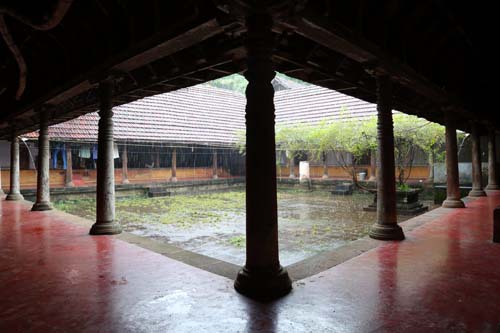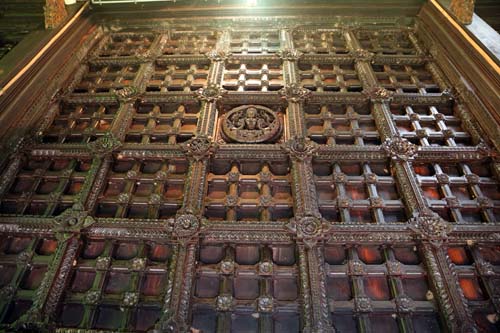Swarnathu Mana

Swarnathu Mana is the best example of Kerala traditional architecture. Swarnathu Mana is situated in Pazhamthottam Village and can be reached by travelling 16 km from Eranakulam, via Pallikkara. This mana is a beautiful creation of 600-years-old traditional architecture in 16 acres of land. The atmosphere here is one that creates a homely feeling. Nature has arranged an air-cooling facility here with big trees, the width of the trunk of which cannot be contained in the hands of two people, and climbers. Crossing the porch, the inner courtyard is reached.

The flooring inside has been done with red oxide. Even after so many years, the floors look fresh, complete and as clear as a mirror. The machu [sealing between tiled roof and room space] has lot of intricate carvings. On one side of machu, a palanquin, which was used during olden days, is kept. The beauty of the doors cannot be described in words. There is a temple dedicated to Bhuvaneshvari. I came to know that it is a temple where, in olden days, Pooram [a temple festival] used to be held with a collection of 9 elephants. There are 2 ways to the temple.
The temple can be entered from inside as well as outside. There are 3 large ponds in the compound. One is meant for bathing the elephant. Except for this one, the other ponds looked unkempt. Architectural styles like dragon face motif, facade, etc. are attractively done on this mana. Besides building complexes like Nalukettu [4 halled with a central courtyard], Ettukettu [8 halled with 2 central courtyards] and Pathinarukettu [16 halled with 4 central courtyards], in Kerala, we can also rarely see Panthrandukettu [12 halled with 4 courtyards]. Swarnathu Mana is also famous for its panthrandukettu features.

From the 2-storied mana, there is a beautifully built bridge connecting it to the granary [pathayapura] which is another 2-storied building and stands at a very short distance from the mana. What is surprising is that it was constructed 200 years back. I saw some framed old-time black-and-white photos and lyrical best wishes [mangalapathram] in the long Pathayapura. On the way to the pond, there is a temple dedicated to Siva. Strolling through the plot of land around the mana is very interesting and one never gets tired.

The singing and chirping of the birds, the coolness of the atmosphere even at midday, all provide a great experience. In olden days, this mana was known as Nedumthuruthi Illam. There is a legendary story regarding the changing of name to Swarnathu Mana. Once Sankara, when he was a child brahmachari [ascetic], went to seek alms at a Brahmin’s house at Punnorcode, Kunnathunadu. During those days, the Illam was in a poor financial situation.

There was only an antharjanam [Brahmin woman] in the house. The woman saw the child with a radiant face standing at the door of the Illam seeking alms, she became very sad. The mana did not have a history of sending back people seeking alms, especially austere people, empty handed. This time, there was nothing to offer, neither rice grain nor money.

The woman went inside and searched for something to give the child. At last, she got a small gooseberry. She reluctantly gave it to the child. Sankara understood the situation of the woman. He accepted the gooseberry and composed Kanakadharasthavam as a prayer to Mahalakshmi.

Mahalakshmi was pleased with the compilation and rained golden gooseberries. Sankara gave those golden gooseberries to the woman. The legend says that the poverty of the Illam was thus put to an end. Later on, it became prosperous and came to be known as Swarnathu Mana.

It is said that it was on the day of Akshaya Tritiya that the child reached the residence of the Brahmin seeking alms. Doing charity on the day of Akshaya Tritiya definitely brings never-diminishing good luck and success. Whatever be the legend, even if we are not glorifying it, let us try not to humiliate Akshaya Tritiya.

There are references in ancient literatures regarding the importance of doing charity on Akshaya Tritiya; they also advise us to give our favorite things to others instead of spending money for buying favorite things and keeping it for ourselves.

I have only one thing to tell the people who wish to get the blessing of Akshaya Tritiya; instead of running after gold ornaments, please take a look around yourselves, look at your brothers and sisters having no food to eat and no new dress to wear, do what you can for them. Service to humans is service to god; the mana has a tradition that puts forward this theory. I gave a big salute to Swarnathu Mana, the pride of Kerala and the architectural creativity of Kerala, and left the place.









